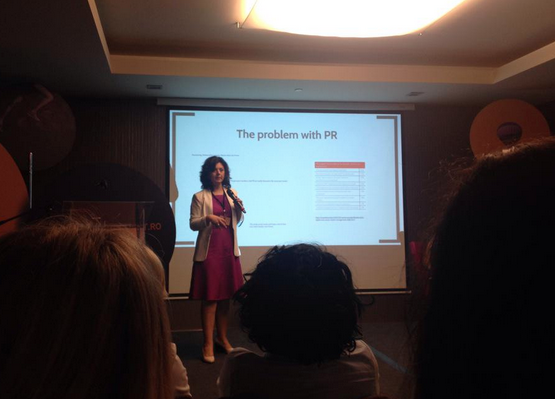I have just returned from Bucharest where I was invited to share the lessons I learned from my consultancy and social media training with SMEs at PR Measurement. Organised by GMP PR, dosage  this was the first conference in Romania focused on measurement of public relations campaigns and outputs. It was also the first conference aiming to bring attention to the Barcelona Principles and invite practitioners to ditch AVEs as measurement for PR efforts.
Seven PR Measurement Principles
- Importance of Goal Setting and Measurement
- Measuring the Effect on Outcomes is Preferred to Measuring Outputs
- The Effect on Business Results Can and Should Be Measured Where Possible
- Media Measurement Requires Quantity and Quality
- AVEs are not the Value of Public Relations
- Social Media Can and Should be Measured
- Transparency and Replicability are Paramount to Sound Measurement
Fronted by Katie Paine, symptoms  an initial founder of the Institute for Public Relations Measurement Commission, visit this  Senior Fellow and Advisory Board member of the Society for New Communications Research (SNCR), organiser of The Conclave that released social media measurement standards and prolific author, the conference had an equally impressive lineup and a programme split between case studies and applications.Â
The morning saw Katie being joined by Ionut Statimir (Head of Communications for BCR/ Romanian Commercial Bank), Anca Oreviceanu (Head of Communications for Dacia Renault Group Romania) and Catalina Mergeani (Marketing Communication Manager NN Romania) who shared their examples of campaign and PR impact measurement including a variety of metrics and a combination of qualitative and quantitative methods. Besides Katie’s witty and insightful keynote,  I found Anca’s talk to be the most interesting. She presented a good programme of evaluation for internal communications, a sector not yet enjoying full support in many organizations in Romania and an area where technology and the internet might not always be effective.
The afternoon was dedicated to applications, tools and trends. Speakers from Google Romania, BRAT, Open-I Research, and Mind Institute shared their lessons and highlighted yet again that good measurement starts with good planning and excellent knowledge of research principles. It is part of this session that I shared my insight and lessons learned from my work with SMEs and the work done previously with the Digital Communication Strategies course.
3 social media lessons from SMEs
- Define how your social media success looks like (successful SMEs know what they want to gain from their social media presence so their posts are building towards that; this requires linking business objectives with social media objectives that are measurable, specific, realistic, timely and attainable – SMART; the AMEC framework is of great help here. Moreover, research prior, during and post campaign is key to ensuring a good evaluation of the efforts in achieved. My slides mention some examples of research that can be carried out.)
- Social media is NOT about you (not all the time, not always; successful SMEs serve their clients and, more than acknowledging their needs, they cater for them. This is why speaking about what the clients want and are interested in is important and understanding that social media is a peer to peer environment, hence the interest is on social exchange and uses and gratifications for the users not the company and brands represented there. Moreover, this is why asking yourself “who cares” and “if I were a client, would I pay attention/share/comment on this” is very important)
- What can you do, realistically and with the resources you have available. (It is no use of spreading yourself too thin just for the sake of being everywhere. Social media requires planning, dedicated and trained staff, and time. There are tools that can help in this process like Hootsuite and BufferApp and it is highly recommended that communicators use them as they will make monitoring easier and they can focus more on listening and scanning for active discussions as well as researching and responding to current demands. I have spoken about this before and will do so again in a few weeks in Lincoln so watch this space for updates on the daily social media routine!)
All in all, it has been a great conference with very promising examples of measurement and research. It has been a pleasure to be part of it and I am truly hoping to have an opportunity to return to see the uptake of the principles and the lessons learned.
